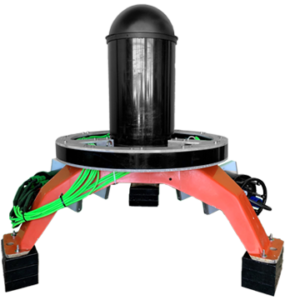The Department of Energy Water Power Technologies Office (WPTO) Triton Initiative is a project that aims to reduce barriers to testing marine energy devices by researching and developing scientifically defendable monitoring technologies to understand potential effects on marine ecosystems. Recently, Triton led an effort for field trials and validation testing of several monitoring technologies and methods for characterizing environmental changes associated with the testing of current energy converters and wave energy converters in various settings.
 BioSonics developed the Omnidirectional Marine Life Observer with support from the WPTO Triton Initiative. The system was tested and optimized at PNNL’s Marine and Coastal Research Lab, and field testing with the SeaRAY system began in February 2023. Later in 2023 the system will be deployed alongside the C-Power SeaRAY marine energy device at the Navy’s Wave Energy Test Site (WETS) in Hawaii. The SeaRAY will provide power and cloud connectivity to the Marine Life Observer, which will autonomously monitor and report on marine life activity during the six-month deployment.
BioSonics developed the Omnidirectional Marine Life Observer with support from the WPTO Triton Initiative. The system was tested and optimized at PNNL’s Marine and Coastal Research Lab, and field testing with the SeaRAY system began in February 2023. Later in 2023 the system will be deployed alongside the C-Power SeaRAY marine energy device at the Navy’s Wave Energy Test Site (WETS) in Hawaii. The SeaRAY will provide power and cloud connectivity to the Marine Life Observer, which will autonomously monitor and report on marine life activity during the six-month deployment.
The research conducted as part of the Triton Initiative has informed recommendations for monitoring practices to improve efficiency and reduce costs for environmental monitoring of marine energy devices based on field trials at open ocean, riverine, and tidal energy sites in the U.S. These recommendations are published in the Journal of Marine Science and Engineering special issue entitled “Technology and Methods for Environmental Monitoring of Marine Renewable Energy.” These recommendations will support data comparability and transferability between marine energy device types and provide common ground for evaluating environmental and ecological impacts among project sites for the marine energy industry.
Topics include:
- Collision risk
- Underwater noise
- Changes in habitat
- Electromagnetic fields
- Anthropogenic light
- Predictive modeling
- Science Communication
- Energy sustainability and life cycle assessment next steps
